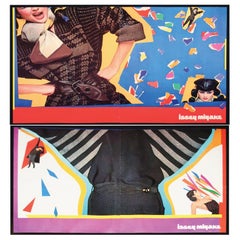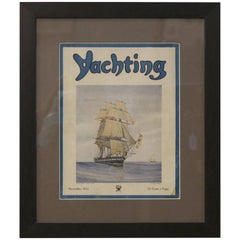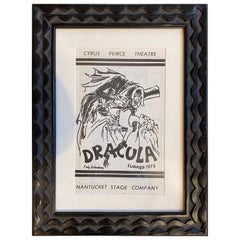Issey Miyake Wall Decorations
From the prismatic Pleats Please collection to the modular, three-dimensional garments crafted from recycled plastic bottles in his Reality Lab, the captivating fashions by Japanese designer Issey Miyake are all about movement.
Born in Hiroshima, Miyake studied graphic design at Tama Art University in Tokyo before relocating to Paris in 1965, where he studied couture and cut his teeth working for Guy Laroche and Hubert de Givenchy. In 1969, he moved to New York, where he worked for Geoffrey Beene. He returned to Tokyo in 1970 to found his first solo venture, the Miyake Design Studio. It wasn’t until the 1990s, though, that the designer had his breakthrough moment with experimentations in pleating. Some of his earliest explorations were for choreographer William Forsythe’s Frankfurt Ballet Company, with the 1991 performance of The Loss of Small Detail featuring costumes Miyake designed with pleats that complemented and transformed the movement of the dancers.
Though long a staple in couture — from delicate women’s skirts to men’s suit pants — pleats took on new life in Miyake’s hands. By using a heat press to cure his fabrics after his garments are stitched, Miyake was able to maintain the accordion structure of the pleat, turning a series of folds into sculptural, often futuristic forms unbound by the shape of the human body. In 1993, Miyake debuted “garment pleating” in his Pleats Please line, in which the clothes are constructed at a size that is larger than what is intended for the finished product. The pleats are then created — a process that involves folding and ironing and is separate from the joining of seams — and individual pieces are subsequently hand-fed into a heat press. The pleats are permanent and the garments can be worn and washed without losing their shape.
Miyake’s pleats run the gamut in scale, which enabled him to evoke dramatic, sharp silhouettes and flowy movements in equal measure. In essence, he created an entirely new material whose iterations are infinite — a feat of technology as much as fashion.
Other innovations include Miyake’s 1997 Just Before collection, which introduced a series of tube-knit dresses that could be cut as desired, reducing both work and resources. His Reality Lab now investigates new materials, such as a fully recycled polyester. Miyake’s prowess, in fact, captured another iconic figure in the tech world: Steve Jobs, for whom the designer made hundreds of identical black turtlenecks, the late Apple founder’s sartorial signature.
Find a collection of vintage Issey Miyake day dresses, jackets, shirts and other clothing on 1stDibs.
Late 20th Century Post-Modern Issey Miyake Wall Decorations
Paper
1930s Vintage Issey Miyake Wall Decorations
1970s American Post-Modern Vintage Issey Miyake Wall Decorations
Paper
1980s French Modern Vintage Issey Miyake Wall Decorations
Aluminum
1840s Antique Issey Miyake Wall Decorations
Paper
1960s American Mid-Century Modern Vintage Issey Miyake Wall Decorations
Glass, Wood, Paper
Early 20th Century American Art Deco Issey Miyake Wall Decorations
Paper
1930s French Mid-Century Modern Vintage Issey Miyake Wall Decorations
Paper
Early 20th Century American Art Deco Issey Miyake Wall Decorations
Paper
1930s French Mid-Century Modern Vintage Issey Miyake Wall Decorations
Paper
1920s French Art Deco Vintage Issey Miyake Wall Decorations
Paper
1810s British Antique Issey Miyake Wall Decorations
Fabric, Glass, Wood, Paper
Early 20th Century American Art Deco Issey Miyake Wall Decorations
Paper
Issey Miyake wall decorations for sale on 1stDibs.
Creators Similar to Issey Miyake
- 1stDibs ExpertApril 5, 2022Issey Miyake features an official website where you can place an online order. You may also find Issey Miyake products sold online by a variety of its retail partners. Browse a range of authentic Issey Miyake pieces from top sellers on 1stDibs.
- 1stDibs ExpertMarch 22, 2022How to tie an Issey Miyake caftan is largely a matter of personal preference. One of the selling points of the piece is that you can wear it a number of ways. Try styling it open as a cardigan or wrapping it around your body like a dress and tying it on the side or in the back. Shop a selection of Issey Miyake apparel on 1stDibs.
- How do I pronounce Issey Miyake?1 Answer1stDibs ExpertMarch 22, 2022To pronounce Issey Miyake, say "I-see mee-AH-kee." The vowel in the first syllable of the first word sounds like the "I" in the word "Interview." Issey Miyake is both the name of a fashion brand and the Japanese designer who founded it. On 1stDibs, find a range of Issey Miyake apparel.
- Where can I buy Issey Miyake?1 Answer1stDibs ExpertMarch 22, 2022In the U.S., you will generally need to buy Issey Miyake through an authorized third-party brick-and-mortar retailer or on a reputable online platform. The brand-owned stores are only in Japan, and the official website does not sell directly to customers. You'll find a selection of Issey Miyake on 1stDibs.
- What is Issey Miyake Fete?1 Answer1stDibs ExpertApril 5, 2022Issey Miyake Fete is a women’s fashion line by designer Issey Miyake that embraces bright colors and eye-catching silhouettes. It takes its inspiration from the French word fête, meaning party, festival or celebration. Shop a collection of Issey Miyake Fete pieces on 1stDibs.
- 1stDibs ExpertApril 5, 2022The line Pleats Please by Issey Miyake is crafted from polyester material that allows it to stay crisply pleated over time. Browse a range of authentic Pleats Please by Issey Miyake pieces from some of the world’s top boutiques on 1stDibs.
- 1stDibs ExpertApril 5, 2022You can buy the Bao Bao bag by Issey Miyake online from their official website. This eye-catching geometric-detailed bag can also be found online, sold by one of their retail partners. Find a range of Issey Miyake Bao Bao bags from top boutiques around the world on 1stDibs.
- 1stDibs ExpertMarch 22, 2022To wash Issey Miyake Pleats Please apparel, follow the care instructions printed on the wash tag. For most pieces, launder in warm water in a washing machine. Use a laundry bag to prevent snagging. Remove the garment from the wash and reshape the pleats by hand. Then, allow it to dry flat in a shady ventilated area. On 1stDibs, find a selection of Issey Miyake apparel.
- Is Issey Miyake high-end?1 Answer1stDibs ExpertFebruary 27, 2024Yes, Issey Miyake is high-end. Since its founding in 1970 by designer Issey Miyake, the Japanese fashion brand has gained a reputation for using fine materials and producing pieces of exemplary quality. Issey Miyake is particularly well-known for offering apparel with unique embellishments like crisp pleats, elaborate folds and dimensional draping. On 1stDibs, shop a variety of Issey Miyake apparel.
- Is Issey Miyake a luxury brand?1 Answer1stDibs ExpertMay 30, 2024Yes, Issey Miyake is a luxury brand. The Japanese fashion label has become famous for using innovative, fine materials, such as fabric that folds like origami, and for using technology to create unique, inventive pieces. For example, the late designer and founder Issey Miyake introduced a series of tube-knit dresses that could be cut as desired in 1997, and his Reality Lab now investigates new materials, such as fully recycled polyester. In addition, the brand has a solid reputation for producing clothing in accordance with lofty quality standards. Find a range of Issey Miyake apparel and accessories on 1stDibs.
- 1stDibs ExpertNovember 13, 2024What Issey Miyake pleats are called is Please Pleats. Though long a staple in couture — from delicate women’s skirts to men’s suit pants — pleats took on new life in Miyake’s hands. By using a heat press to cure his fabrics after his garments were stitched, Miyake was able to maintain the accordion structure of the pleat, turning a series of folds into sculptural, often futuristic forms unbound by the shape of the human body. In 1993, Miyake debuted “garment pleating” in his Pleats Please line, in which the clothes are constructed at a size larger than what is intended for the finished product. The pleats are then created — a process that involves folding and ironing and is separate from the joining of seams — and individual pieces are subsequently hand-fed into a heat press. The pleats are permanent, and the garments can be worn and washed without losing their shape. Miyake’s pleats run the gamut in scale, which enabled him to conjure dramatic, sharp silhouettes and flowy movements in equal measure. In essence, he created an entirely new material with infinite iterations — a feat of technology as much as fashion. Explore a range of Issey Miyake apparel and accessories on 1stDibs.
- 1stDibs ExpertAugust 29, 2024To tell if an Issey Miyake bag is real, first look at the studs inside. Authentic bags will feature shiny studs, while replicas often have matte studs. On one stud, you will typically find a clear Issey Miyake logo tag. By comparing this tag to images of authentic labels shared on trusted online resources, you can determine if any discrepancies may indicate your bag is not real. Next, examine the individual geometric pieces that make up the bag. On a genuine Issey Mikaye, these pieces will be of uniform size and shape. Inconsistencies are usually the sign of a counterfeit. If you're still unsure about your bag's authenticity, a certified appraiser or other knowledgeable expert can be of assistance. Shop a variety of Issey Miyake bags, apparel and accessories on 1stDibs.
- 1stDibs ExpertMarch 22, 2022To spot fake Issey Miyake clothing, examine the labels to ensure that the logo is in the correct font and that information printed on the sales tags and the labels matches. Because spotting counterfeits can be challenging, the brand advises customers to contact them directly with questions about authenticity. You'll find a collection of expertly vetted Issey Miyake clothing on 1stDibs.
- 1stDibs ExpertMarch 22, 2022Issey Miyake designs women's apparel with a distinctive contemporary style. Many of the brand's designs feature three-dimensional flourishes, such as dramatic pleats. Asymmetrical silhouettes and bold abstract prints are other common characteristics of the designer's looks. Shop a collection of Issey Miyake apparel on 1stDibs.


